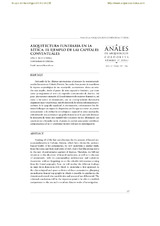| dc.contributor.author | Ruiz Osuna, Ana B. | es_ES |
| dc.date.accessioned | 2011-03-02T09:27:21Z | |
| dc.date.available | 2011-03-02T09:27:21Z | |
| dc.date.issued | 2006 | |
| dc.identifier.issn | 1130-9741 | |
| dc.identifier.uri | http://hdl.handle.net/10396/4424 | |
| dc.description.abstract | Starting off of the last contributions for the process of funeral monumentalización in Colonia Patricia, which have shown the archaeological wealth of his cementeries, we now undertake a ampler study, from the space and historical point of view, that it has like protagonists to the rest of conventuales capitals of Baetica. Therefore, we will pay attention to the discovery of funeral enclosures, as well as to the rest of monumenta, with its corresponding architectonic and sculptoric decoration, without forgetting to us the valuable information coming from the burial epigraphy. Next, we will overlap the different fi ndings in maps from dispersion with which to undertake a fi rst approach to the chronological and space evolution of these cementeries, glimpsing an authentic funeral topography in which is possible to emphasize the detection of several viae sepulchrales and spaces of use differential. The obtained conclusions will be the departure point to be able to establish comparisons to the use and to conform futures works of investigation. | en |
| dc.description.abstract | Partiendo de las últimas aportaciones al proceso de monumentalización funeraria en Colonia Patricia, las cuales han puesto de manifi esto la riqueza arqueológica de sus necrópolis, acometemos ahora un estudio más amplio, desde el punto de vista espacial e histórico, que tiene como protagonistas al resto de capitales conventuales de Baetica. Así pues, prestaremos atención al descubrimiento de recintos funerarios, así como a los restos de monumenta, con su correspondiente decoración arquitectónica y escultórica, sin olvidarnos de la valiosa información procedente de la epigrafía sepulcral. A continuación, imbricaremos los distintos hallazgos en mapas de dispersión con los que acometer un primer acercamiento a la evolución cronológica y espacial de estas necrópolis, vislumbrando una auténtica topografía funeraria en la que cabe destacar la detección de varias viae sepulchrales y espacios de uso diferencial. Las conclusiones obtenidas serán el punto de partida para poder establecer comparaciones al uso y conformar futuros trabajos de investigación. | es_ES |
| dc.format.mimetype | application/pdf | es_ES |
| dc.language.iso | spa | es_ES |
| dc.publisher | Universidad de Córdoba, Área de Arqueología | es_ES |
| dc.rights | https://creativecommons.org/licenses/by/3.0/ | es_ES |
| dc.source | Anales de Arqueología Cordobesa 17(1), 157-194 (2006) | es_ES |
| dc.subject | Arqueología | es_ES |
| dc.subject | Yacimientos funerarios | es_ES |
| dc.subject | Bética | es_ES |
| dc.title | Arquitectura funeraria en la Bética: el ejemplo de las capitales conventuales | es_ES |
| dc.type | info:eu-repo/semantics/article | es_ES |
| dc.relation.publisherversion | https://www.uco.es/ucopress/ojs/index.php/anarcor/index | es_ES |
| dc.rights.accessRights | info:eu-repo/semantics/openAccess | es_ES |

